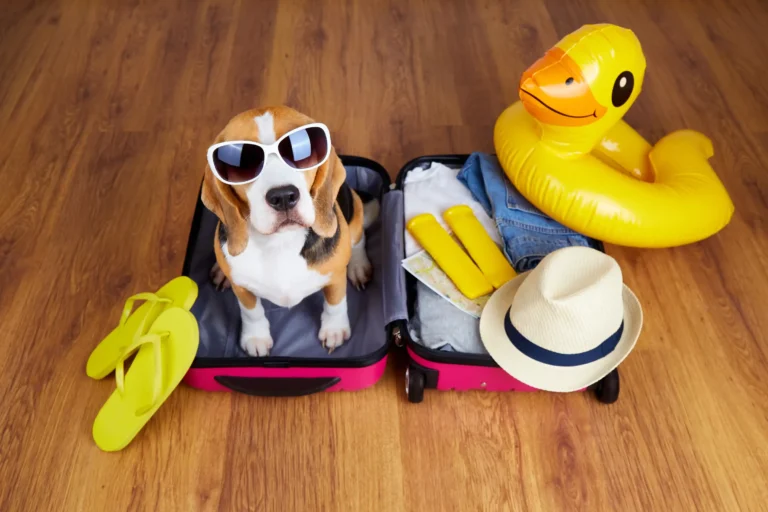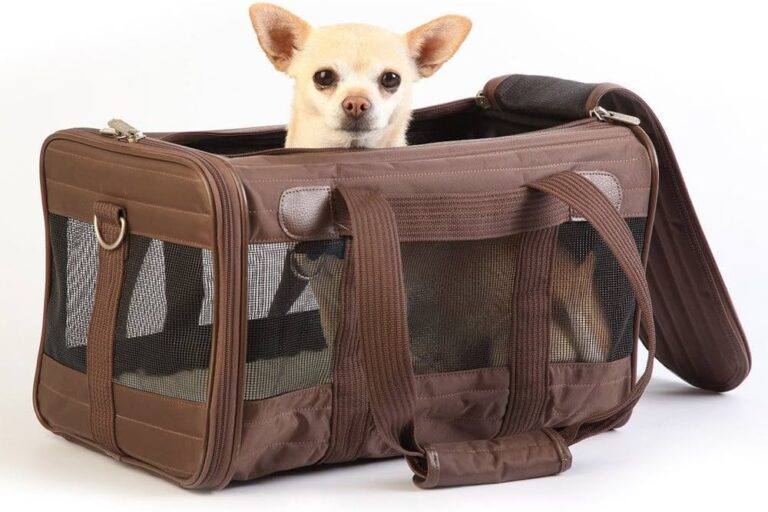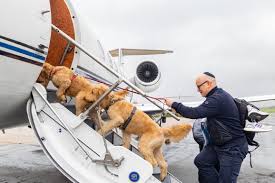Planning the perfect road trip with your petite pooch in tow can seem like a daunting task. Fear not, however, because ‘Paws and Pedals: The Ultimate Guide to Planning a Road Trip with Your Small Pup’ has arrived! This comprehensive guide will lead you step by step, from packing essentials to finding pet-friendly accommodations. 🐾🚗
In this detailed guide, we’ll explore a myriad of tips and tricks to ensure a smooth ride with your little furry companion. We will delve into the crucial aspects of pre-trip preparation, including what to pack, health checks, and strategies for keeping your pup entertained during the journey. We’ll also share our top picks for dog-friendly destinations and pit stops, ensuring that your adventure is enjoyable for both you and your four-legged friend.
Moreover, we’ll arm you with essential information on how to handle unexpected situations that might arise on the road. We’ll discuss what to do if your dog gets car sick, how to handle emergencies, and how to find nearby veterinary services when you’re far from home. Whether you’re a seasoned road tripper or planning your first adventure, ‘Paws and Pedals’ is your ultimate companion for a memorable trip with your small pup. Get ready to hit the open road and make some unforgettable memories with your furry best friend! 🐶🛣️
Preparation and Essentials
When planning a road trip with your small pup, the first and most crucial step is to ensure that you are adequately prepared. Road trips can be incredibly fun and memorable experiences, but they also present unique challenges when you have a four-legged companion along for the ride. Careful consideration of various factors, including the duration of the trip, the breed and size of your dog, and potential obstacles you may encounter, will make all the difference in ensuring a smooth and enjoyable journey for both you and your pet.
Packing Essentials
Being well-prepared with the right gear is key to a successful road trip with your pup.
Food and Water
Always bring enough food and water to last the entire duration of your trip, with extra supplies to cover unexpected delays. Stick to your dog’s regular diet to avoid upsetting their stomach, and bring along a travel-friendly water dispenser to make hydration easy on the go.

Collar and Leash
A well-fitted collar and a sturdy leash are essential for safety. For small dogs, a harness can offer better control and can prevent strain on the neck, especially for breeds prone to tracheal collapse. Always inspect the leash and collar for wear and tear before setting off.
Identification Tags
Ensure that your dog’s ID tags are updated with current information. These tags should clearly display your dog’s name, your phone number, and any important medical details, such as allergies. Consider microchipping your dog as an additional security measure.
Comfort Items
To help your small dog feel more at ease, pack their favorite blanket, a familiar toy, or even a pillow they often sleep on. Familiar scents can greatly reduce anxiety and help your pet adjust to different environments during your trip.
First Aid Kit
A well-stocked pet first aid kit is a must-have. Essential items should include bandages, antiseptic wipes, tweezers for removing ticks or splinters, a pet-safe thermometer, hydrogen peroxide (to induce vomiting if recommended by a vet), and a basic pet first aid manual.

Health Check-ups and Vaccinations
Before embarking on any trip, especially a long one, schedule a veterinary check-up. Ensure your dog is up to date on all vaccinations and preventive treatments for fleas, ticks, and heartworms. Discuss any health concerns or travel anxieties you might have with your vet. If your dog has a history of car sickness, your vet may recommend medication or natural remedies to ease the symptoms.
Carry a copy of your dog’s vaccination records and a certificate of health, as some hotels and campgrounds require proof that pets are healthy and vaccinated.
Choosing the Right Vehicle
Selecting the right vehicle can make all the difference when traveling with a small pup. Comfort and safety should be your top priorities.
If you own a compact car and your dog is accustomed to it, that might suffice. However, if you are renting a vehicle or upgrading for a road trip, look for pet-friendly features such as spacious back seats, rear air vents, and flat floors for securing carriers or crates.
Small dogs may not require vast amounts of space, but having an area where they can comfortably lie down, sit up, and stretch a little makes the trip much more pleasant for them.
Vehicle Safety Features
Some vehicles come equipped with built-in pet barriers, which can prevent your dog from moving around and distracting the driver. Rear seatbelt clips that attach to harnesses are also an excellent way to secure your dog safely.
Never allow your dog to ride unrestrained, as this can be dangerous for both of you. In the event of a sudden stop or accident, a restrained dog is less likely to be injured or become a projectile hazard.
Seat Covers and Pet Barriers
Investing in durable seat covers is a smart idea. They protect your car’s upholstery from hair, dirt, and accidents while making clean-up much easier. Waterproof covers are especially useful if you are traveling to areas where your pup might get wet or muddy.
Pet barriers, whether installed or portable, are practical for keeping your dog confined to the back seat area. This helps reduce distractions and keeps your dog safer throughout the journey.
Planning the Route and Stops
Mapping out your route ahead of time can make a significant difference in your travel experience. Identify pet-friendly rest stops, parks, and accommodations along the way.
Plan to stop every two to three hours to allow your dog to stretch, relieve themselves, and get some exercise. These breaks not only benefit your dog’s physical health but also provide mental stimulation and help prevent travel-related stress.
Pet-Friendly Accommodation
If your road trip spans several days, finding pet-friendly accommodations is essential. Many hotel chains, motels, and campgrounds welcome pets, but policies vary widely.
When booking accommodations:
- Confirm pet policies in advance, including fees, size restrictions, and any rules regarding pets being left unattended in rooms.
- Look for places that offer amenities like dog parks, walking trails, or pet-welcome packages.
- Bring a portable crate or dog bed to give your pup a designated sleeping area that feels safe and familiar.
Parks and Rest Stops
Plan your route to include stops at pet-friendly parks, rest areas, and open spaces where your dog can move freely. Many state and national parks allow dogs on leashes, and some even have designated off-leash areas.
Research the regulations of each park you plan to visit. Always clean up after your dog and follow leash laws to ensure a welcoming environment for future travelers with pets.
Training and Behaviour
Good behavior is essential for a pleasant road trip experience. In the weeks leading up to the trip, work on reinforcing basic commands such as sit, stay, come, and leave it. These commands can be lifesaving in unfamiliar areas.
Training for Car Travel
If your small dog is not used to car rides, start with short drives around the neighborhood. Gradually increase the distance and duration to build their tolerance. Reward calm behavior with treats and praise.
Teach your dog to associate the car with positive experiences. Avoid only taking them to the vet or other stressful places in the car. Instead, drive to a park, a friend’s house, or another enjoyable destination.
Dealing with Anxiety and Car Sickness
Car anxiety and motion sickness are common issues for dogs. If your dog shows signs of distress, such as drooling, whining, or restlessness, take it seriously.
Solutions include:
- Using calming pheromone sprays designed for pets.
- Providing a favorite toy or chew to distract them.
- Keeping the car cool and well-ventilated.
- Ensuring your dog faces forward and has a stable place to sit.
Consult your vet for anti-nausea medications or natural calming remedies if needed.
Keeping Your Pup Entertained
Keeping your small dog entertained during the journey is important for their mental health and your sanity.
Interactive toys, chew toys, and puzzle feeders can keep your dog busy while you focus on the road. Rotate toys periodically to keep them interesting.
Include short training sessions during stops to engage your dog’s mind and reinforce good behavior. Teaching a new trick during a rest break can be a fun bonding experience.
Parks and Rest Stops
Identify parks and rest stops along your route where your pup can stretch their legs. Remember, a tired dog is a good dog, particularly when on a road trip.
Training and Behaviour
Training your small pup for the journey is just as important as physical preparation. A well-trained dog will not only feel more comfortable during travel but will also behave better in new and potentially stressful environments.
Begin with short car rides to gradually introduce your dog to the experience of being in a moving vehicle. Start by letting them sit in the car without the engine running, offering praise and treats for calm behavior. Once they are comfortable, take very short drives around the block, progressively extending the duration as they become more at ease.
Teaching your pup to enter and exit the car safely is another crucial part of their training. Always have them wait for a command before jumping in or out of the vehicle. This prevents accidents, especially when parked near traffic. Use positive reinforcement techniques, rewarding your dog with treats and affection when they follow commands successfully. This helps to build positive associations with car travel and ensures a safer, more controlled environment.
Additionally, teach your dog to settle in their designated car area, whether it’s a crate, a car seat, or a harnessed seatbelt. Remaining calm and seated during the drive prevents injuries and distractions while driving.
Dealing with Anxiety and Car Sickness
Some dogs experience anxiety or motion sickness when traveling by car, which can make road trips challenging for both the pet and the owner. Identifying the signs early and addressing them appropriately is key to improving your pup’s comfort.
Common signs of car anxiety include whining, drooling, pacing, shaking, and excessive panting. Dogs suffering from motion sickness may vomit, drool excessively, or appear lethargic.
Consult your veterinarian if you suspect that your dog has either issue. They may recommend anti-nausea medications, calming supplements, or prescribe medication specifically to reduce anxiety. Natural remedies like calming pheromone sprays, herbal supplements, and Thundershirts can also be effective for some dogs.
Behavioral strategies can work wonders as well. Conditioning your dog to view the car as a positive space, as mentioned earlier, is highly effective. Offering special treats, favorite toys, or a calming music playlist specifically designed for dogs can also help them relax.
If your dog suffers from severe car sickness, feeding a light meal several hours before the trip rather than right before departure can help. Keeping the car well-ventilated and allowing them to face forward, rather than sideways or backward, can also reduce symptoms.
Keeping Your Pup Entertained
Keeping your pup entertained during the journey is crucial for maintaining their happiness and preventing boredom-induced behaviors like whining, chewing, or scratching. Dogs, especially younger ones, need mental stimulation just as much as physical exercise.
Interactive toys such as treat-dispensing balls, puzzle toys, and durable chew toys are excellent options for car rides. They can keep your pup engaged for extended periods without needing much supervision.
Rotate different toys throughout the journey to keep your dog’s interest piqued. Familiar toys from home can provide comfort, while new toys introduced during the trip can add excitement. Ensure all toys are safe and free from small parts that could become choking hazards.
Audio stimulation can also benefit some dogs. Studies show that dogs respond positively to certain types of music, particularly classical or specially composed dog music. Playing calming tracks during the drive may create a more relaxing atmosphere inside the car.
Frequent breaks are another essential aspect of keeping your pup happy. Use pit stops not just for bathroom breaks but also for short walks, light training exercises, or games like fetch if possible. These activities help expend pent-up energy and reduce restlessness during the ride.
Remember, a mentally and physically stimulated dog is far less likely to experience stress or behavioral problems during long drives.



